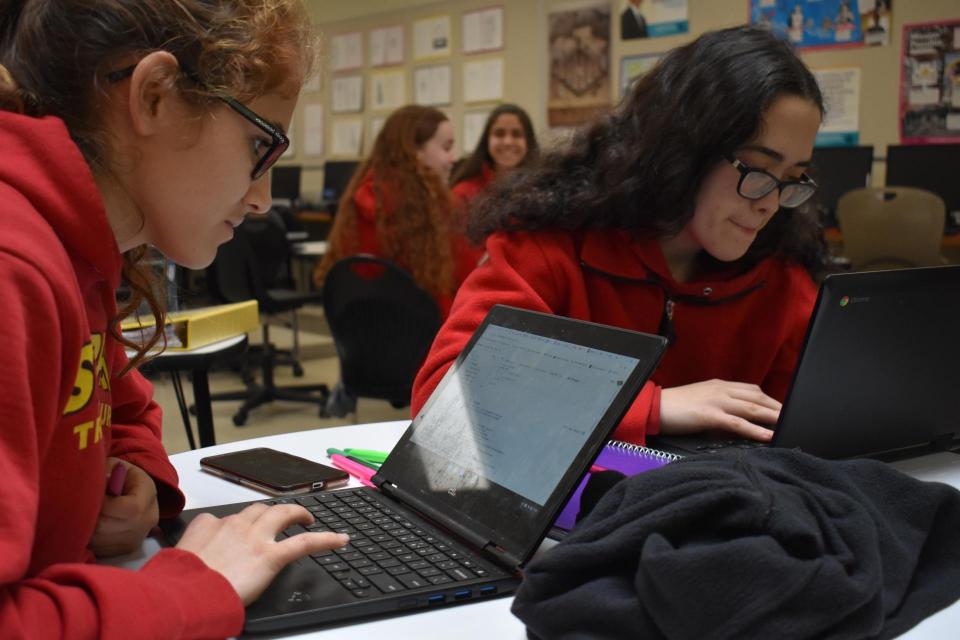St. Francis Catholic High School Earns Dual AP® Computer Science Female Diversity Award
Recognized for Closing the Gender Gap in Computer Science A & Computer Science Principles
Sacramento, Calif. – St. Francis Catholic High School is proud to be a recipient of the College Board AP® Computer Science Female Diversity Award for achieving high female representation in AP Computer Science A and AP Computer Science Principles. This is the third year in a row St. Francis has earned the award. Schools honored with the AP Computer Science Female Diversity Award have expanded girls’ access in AP Computer Science courses.
St. Francis’ C-STEM program is led by instructors Jeffrey Chamberlain and Lisa Coffman: “I am very pleased that College Board AP has chosen to recognize St Francis Catholic High School with the Female Diversity Award,” states Chamberlain. “I see it as a recognition of the hard work that the staff and faculty have invested in ensuring that every Troubie gets the opportunity to participate in STEM classes. It is a recognition of the priority that the St. Francis community has placed on preparing our students for their future. I know that our students are given amazing opportunities at St. Francis Catholic High School, and it is nice to know that College Board AP agrees.”
Out of the 20,000 institutions that offer AP courses, 1,119 achieved either 50% or higher female representation in AP computer science courses or a percentage of the female computer science examinees meeting or exceeding that of the school’s female population during the 2019-2020 school year. That’s nearly 37% more than the 818 schools recognized last year. In 2019, St. Francis was one of only 56 to be recognized for closing the gender gap in both AP computer science courses.
“Today’s students need the power to shape technology, not just cope with it,” says Stefanie Sanford, College Board chief of global policy and external relations. “Young women deserve an equal opportunity to become the next generation of entrepreneurs, engineers and tech leaders. Closing the gap in computer science education empowers young women to build the future they want.”
The first year of AP Computer Science Principles in 2016-17 attracted more students than any other AP course debut, and participation is on the rise. In 2020, more than 116,000 students took the AP CSP Exam—more than double the number of exam takers in the course’s first year, and a 21% increase over the previous year. In 2020, 39,570 women took the AP CSP exam, nearly three times the number who tested in 2017. The number of female AP CSA exam-takers has increased by nearly 25%.
Providing female students with access to computer science courses is necessary to ensuring gender parity in the industry’s high-paying jobs and to drive innovation, creativity, and representation. The median annual wage for computer and information technology occupations was $88,240 in May 2019. However, a code.org analysis of 2017 Bureau of Labor Statistics data finds women represent just 24% of the 5 million people in computing occupations.
That’s why new College Board research about AP CSP is so encouraging. According to the data, female students who take AP CSP in high school are more than 5 times as likely to major in computer science in college, compared to similar female students who did not take CSP. The study also finds AP CSP students are nearly twice as likely to enroll in AP CSA, and that for most students, AP CSP serves as a stepping-stone to other advanced AP STEM coursework.
These findings make it all the more imperative that schools nationwide achieve gender parity in AP Computer Science classrooms. The 1,119 schools that receive this year’s AP Computer Science Female Diversity Award should serve as inspirations and models for all American high schools, where overall, female students remain under-represented in computer science classes, comprising just 34% of AP Computer Science Principles participants. So there is a long way to go to achieve equal gender representation in the field of computer science. Currently, less than half of the nation’s high schools teach foundational computer science, a clear opportunity to be addressed by strong partnerships between policymakers, the tech industry, and educators.
FOR IMMEDIATE RELEASE
Contact: Tina Tedesco
(916) 737-5015
ttedesco@stfrancishs.org





